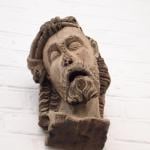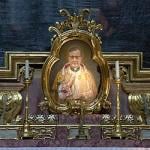HAMLET: If in King Lear the tragic sidekick’s role is restricted by the larger story, in Hamlet his role expands to become the central story. In creating Hamlet, and shoving him into the role of a revenger, Shakespeare thrusts his new type of marginal character onto the center stage. Hamlet’s character is in many ways an extension of Mercutio; he has a similar ironic view of the world, the same sense of being on the margins (he, unlike Shakespeare’s other tragic heroes, does not seem to know the title of his play), and the same dilemma of a vigorous intellect facing the physical reality of death. At the beginning of the play Hamlet clearly sees himself in Mercutio’s role, as the ironic commenter on the fringes of the Danish court, his separation from the spies and speechmakers around him made more obvious by his mourning clothes. His first words, “A little more than kin and less than kind” (I.ii.67), would have made Mercutio grin with their mixture of bitterness and ironic humor. Like Mercutio, he never loses this sense of humor, whether explaining to Horatio that Claudius and Gertrude married immediately after old Hamlet’s death so that “The funeral baked meats” could “coldly furnish forth the marriage tables” (I.ii.187-8) or mocking Osric’s position at court by calling him “spacious in the possession of dirt” (V.ii.101). Like Falstaff, he uses his wit and imagination as a defense against Claudius’s schemes and surveillance, as when he befuddles Polonius by calling the old man a “fishmonger” (II.ii.190). His wit, like that of his predecessors, also acknowledges the danger underlying its humor; Hamlet’s answer to Polonius’s question, “Will you walk out of the air, my lord?”, is “Into my grave?” (II.ii.224-5)–an entirely justified and not only ironic response. He does not see himself as a marginal figure separate from the play’s center; he, like the Fool, Mercutio, and Falstaff, has too much at stake to be a Thersites-like griper or malcontent. Unlike those characters, however, he wants to fill the role of the hero, and knows that he cannot. Throughout the play he compares himself to his models of heroism, whether on the stage or the battlefield, and he never measures up; this self-image as tragic sidekick rather than tragic hero becomes part of his conflict.
The treatment of death in Hamlet fits better with Mercutio or Falstaff’s opinions of it than Romeo or Hal’s. Although through most of the play Hamlet is caught up in considerations of the metaphysical aspects of death, toward the end he begins to take a far less abstracted view of death; it becomes not “sleep” or “The undiscovered country from whose bourn/No traveler returns” (III.i.72, 87-8), but simply the end of the body and the mind, inevitable and ignoble. The wit which he shares with the tragic sidekicks serves him well when he finally must come to terms with the reality of his own approaching death; he comes in Act V not only to the calm fatalism of “If it be now, ’tis not to come; if it be not to come, it will be now; if it be not now, yet it will come” (V.ii.234-6), but also the appreciation of the physical comedy of death in the graveyard scene. The play’s grim ending accords with Hamlet’s disillusionment with the idea of the “noble death.” Although there is an ooutward appearance of justice and symmetry, with Laertes killed “as a woodcock to mine own springe” (V.ii.336) and Claudius dead by “a poison tempered by himself” (V.ii.360), the audience does not leave feeling that justice has been served and Hamlet has died defending his father’s honor against the usurper. Fortinbras’s final summation of Hamlet’s character gets him completely wrong, saying that he would “have proved most royal” and that “the soldier’s music and the rite of war/Speak loudly for him” (V.ii.444-6). Fortinbras, attempting to cast Hamlet as a tragic hero, erases the true picture of Hamlet as a brilliant, humorous man tormented by his inability to act as a hero, his lingering on the margins of his own tragedy.
In moving the marginal character to the center of the play, Shakespeare makes explicit the criticisms of both tragic form and heroism which are implicit in the creation of the Mercutio-Falstaff archetype. By forcing a character who cannot play the tragic hero’s role into the tragic hero’s story, Shakespeare points out the artificiality of more typical tragedies; he throws the play off balance, calling into question the assumptions underlying other tragedies. In Hamlet, pursuit of abstractions like heroism and revenge leads only to meaningless deaths, from the mistaken killing of Polonius to the carnage which ends the play. Hamlet, knowing that his actions will have consequences, must untangle the possible results of his actions and weigh their justifications in a way that the tragic hero can simply avoid; he can never assume that he is in the right. He even admires Fortinbras, who is much more of a hero-type than he is, praising the other prince’s “spirit with divine ambition puffed” (IV.iv.52). When he compares his own inaction and confusion to the player who “But in a fiction, in a dream of passion” (II.ii.579) can take heroic action while he cannot, Shakespeare makes the audience understand both his anguish and the falseness of his model. In Hamlet heroism itself becomes entirely theatrical: even a murderer like Claudius can wrap himself in kingly glory; even a thoughtless warmonger like Fortinbras can seem valiant. Shakespeare both connects heroic ideals and theatrical pretense, and places their “un-theatrical” (one of the play’s paradoxes is that its central character insists that he is not an actor) and un-heroic opposite at the center of the play. In this way he overturns the audience’s view of the hero even more profoundly than he did with Mercutio and Falstaff, who eventually had to move aside so that the hero could emerge.











